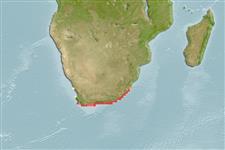Пластиножаберные (акулы и скаты) (sharks and rays) >
Carcharhiniformes (Ground sharks) >
Pentanchidae (Deepwater catsharks)
Etymology: Haploblepharus: haplos (Gr.), single or simple; blepharon (Gr.), eyelid, referring to simple structure of lower eyelid, which closes against upper eyelid to protect the eye. (See ETYFish); fuscus: Latin for dusky, dark or swarthy, probably referring to its overall drab-brown coloration. (See ETYFish).
More on author: Smith.
Environment: milieu / climate zone / depth range / distribution range
экология
морской ассоциированный с рифами. Subtropical; 30°S - 35°S
Southeast Atlantic: just west of Cape Agulhas to southern Natal in South Africa (Ref. 5578). This species is sympatric with Haploblepharus edwardsii in the southeastern Cape region but there is at least partial microhabitat separation between the two - Haploblepharus fuscus occurs inshore while Haploblepharus edwardsii occurs in deeper water offshore (Ref. 244).
Size / Вес / Возраст
Maturity: Lm ? range ? - ? cm
Max length : 69.0 cm TL самец/пол неопределен; (Ref. 244); 73.0 cm TL (female)
Краткое описание
определительные ключи | морфология | морфометрия
колючие лучи спинного плавника (общее число) : 0; колючие лучи анального плавника: 0. The largest shyshark, usually plain yellowish-brown above becoming just yellowish below; small light spots and indistinct brown saddles in some specimens (Ref. 5578).
Found close inshore on the continental shelf, often in shallow, rocky areas (Ref. 244). Feeds on lobsters, crabs and small bony fish (Ref. 5578). Oviparous (Ref. 50449). Readily kept in captivity (Ref. 244). Caught by shore anglers (Ref. 5578).
Life cycle and mating behavior
Maturities | размножение | Spawnings | Egg(s) | Fecundities | личинки
Oviparous, laying 2 egg cases at a time (Ref. 11228). Embryos feed solely on yolk (Ref. 50449).
Compagno, L.J.V., 1984. FAO Species Catalogue. Vol. 4. Sharks of the world. An annotated and illustrated catalogue of shark species known to date. Part 2 - Carcharhiniformes. FAO Fish. Synop. 125(4/2):251-655. Rome: FAO. (Ref. 244)
Статус Красного Списка МСОП (Ref. 130435)
Угроза для людей
Harmless
Использование человеком
рыболовство: рыболовство как средство для существования; объект спортивного рыболовства: да
дополнительная информация
инструменты
Специальные отчеты
Скачать в формате XML
ресурсы в Интернет
Estimates based on models
Preferred temperature (Ref.
123201): 17.1 - 23.4, mean 20.8 °C (based on 49 cells).
Phylogenetic diversity index (Ref.
82804): PD
50 = 0.5625 [Uniqueness, from 0.5 = low to 2.0 = high].
Bayesian length-weight: a=0.00355 (0.00176 - 0.00714), b=3.09 (2.91 - 3.27), in cm total length, based on LWR estimates for this (Sub)family-body shape (Ref.
93245).
Trophic level (Ref.
69278): 4.0 ±0.63 se; based on food items.
устойчивость к внешним воздействиям (Ref.
120179): низкий, минимальное время удвоения популяции 4.5-14 лет (Fec assumed to be <100).
Fishing Vulnerability (Ref.
59153): Moderate to high vulnerability (49 of 100).
Nutrients (Ref.
124155): Calcium = 8.34 [1.79, 45.04] mg/100g; Iron = 0.369 [0.095, 1.072] mg/100g; Protein = 19.2 [16.1, 22.2] %; Omega3 = 0.121 [0.049, 0.280] g/100g; Selenium = 13.1 [3.8, 40.2] μg/100g; VitaminA = 40.7 [13.6, 130.3] μg/100g; Zinc = 0.589 [0.272, 1.236] mg/100g (wet weight);
